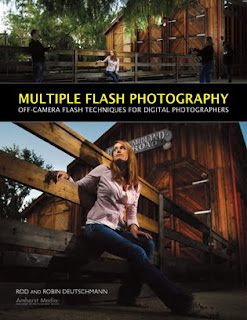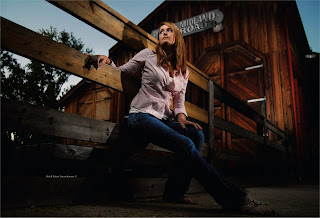 Today's post comes from the book Multiple Flash Photography: Off Camera techniques for Digital Photographers by Rod & Robin Deutschmann. It is available from Amazon.com and other fine retailers.
Today's post comes from the book Multiple Flash Photography: Off Camera techniques for Digital Photographers by Rod & Robin Deutschmann. It is available from Amazon.com and other fine retailers.When you have a purpose, everything makes sense. Here, we wanted total control over the image. The aperture and shutter speed settings were quickly dialed in to eliminate any ambient light. From this, we began adding our flashes, lighting one graphic tier of information at a time. It took five unmodified flashes—three pointed at our model and two pointed toward various tiers in the background—to accomplish our objective.

First, the base light was chosen by using an aperture and shutter-speed combination that stripped the natural light from the scene.

We always work from the back forward, adding light as we move. Here, one flash was used to illuminate the train car.

Two more lights were added, one to the side of the model and one on the ground.

Two more lights were added, one to the side of the model and one on the ground.

Finally, the photographer added the last flash with his hand-held unit. Note how different the day actually looks compared to the final image on the opposite page.

PUTTING IT ALL TOGETHER: ONE MORE FIVE-LIGHT SETUP
Two extending handles, five unmodified flashes shooting at full power, three assistants, and five minutes of light remaining—man, this multiple light stuff is fun! It all comes down to experience. The more you have, the more quickly you can create unforgettable images. It’s an added bonus when each and every person involved in a shoot knows not only what they are doing but what everyone else is doing as well. When we get a group of photographers together to test out equipment or simply take fun pictures, the whole process becomes one fluid movement. Each person knows their part and each is invested in a successful final outcome. This feeling of shared responsibility is contagious. It’s hard to go wrong when everyone cares.

This image shows what the chosen base light looked like.

Here, an assistant helps light the barn with one hand-held unit.

Quickly, each of us assumed a position. One person grabbed an older flash, attached a radio receiver to it, and aimed it at the barn itself. Another assistant took hold of a homemade ten-foot extending handle. The remaining assistant picked up the smaller Lastolite model. Both equipped their “light sticks” with two separate flashes; one sat atop the handle, while the other directed light from a lower section. The photographer quickly grabbed a wide-angle lens, attached a radio transmitter to the top of the camera, and dialed in the appropriate white balance, contrast, and saturation settings. He then picked an aperture and shutter speed and asked each member of the team to take their position. In less than five minutes, the final image was created.

BUY THIS BOOK FROM AMAZON

No comments:
Post a Comment